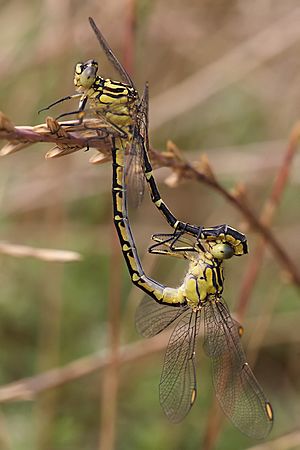Mating facts for kids
Mating is when two organisms come together to create new life. This usually happens for making offspring. Sometimes, the word "mating" is used only for animals. But it can also describe how plants and fungi share their genetic material. When plants or fungi do this, it's often called cross-fertilization or "crossing." This means the new plant or fungus gets DNA from both parents.
When animals mate, they often join their bodies. This is called copulation. It allows for fertilization to happen inside the body. Fertilization is the moment when special cells from both parents combine.
Mating can also lead to fertilization happening outside the body. Many amphibians, most fish, and some other water animals do this. They release their eggs and sperm into the water at a specific time of year. This timing can be different for each species.
Some organisms, called hermaphrodites, can fertilize themselves. This means they don't need another partner to reproduce. For example, some flowering plants can self-pollinate within the same flower. Also, some hermaphrodite animals can self-fertilize. Many snails and earthworms are hermaphrodites. They often mate in pairs, joining together at the same time.
For some birds, mating involves more than just joining together. It can also include building a nest and helping to feed their young. Humans also help animals reproduce through artificial insemination. This is a common practice in animal husbandry for farm animals.
Contents
How Animals Reproduce
Animals have different ways of coming together to make new life. This process is important for all species to continue existing. Some animals join their bodies, while others release their reproductive cells into the environment.
Internal Fertilization in Animals
When animals join their bodies to reproduce, it's called copulation. This allows the special cells from the male to meet the special cells from the female inside her body. This process is known as internal fertilization. Many mammals, birds, and reptiles reproduce this way.
External Fertilization in Animals
Some animals, especially those living in water, reproduce using external fertilization. This means the male and female release their special cells (eggs and sperm) into the water. The cells then meet and combine outside their bodies. Frogs and most fish use this method. They often release their cells at the same time to increase the chances of fertilization.
Self-Fertilization in Some Species
Not all organisms need a partner to reproduce. Some hermaphrodite species can fertilize themselves. This is like a single organism being able to do both jobs needed for reproduction. For example, some snails and earthworms are hermaphrodites. While they can sometimes self-fertilize, they often still mate with another of their kind.
Mating Behaviors
Mating isn't just about the physical act of reproduction. For many animals, it involves special behaviors. These behaviors help them find a partner and prepare for raising young.
Courtship Rituals
Many animals have unique ways of attracting a mate. These are called courtship rituals. They can include special dances, songs, or displays of bright colors. For example, male birds often sing or show off their feathers to attract a female. These rituals help animals choose a strong and healthy partner.
Parental Care After Mating
For some animals, mating is just the beginning of their journey. After mating, they might work together to build a nest or protect their eggs. Some birds, for instance, will build a nest and then both parents will help feed their chicks once they hatch. This parental care helps the young survive and grow.
Images for kids
-
Hermaphroditic snails (Cornu aspersum) mating
-
Chalkhill blue butterflies (Lysandra coridon) mating
-
Hoverflies (Simosyrphus grandicornis) mating in midair
-
Ladybugs mating
See also
 In Spanish: Apareamiento para niños
In Spanish: Apareamiento para niños










